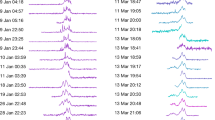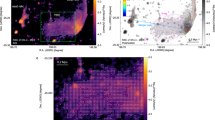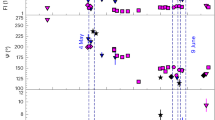Abstract
THE magnetic dipole model for a compact extragalactic radio source proposed by Sanders1,2 and discussed by Milgrom and Bahcall3 and by Sanders and DaCosta4, accounts for one of the features observed in a few of these sources—the apparently superluminal separation of two components (see ref. 5). However, the magnetic dipole model requires a strong, well-ordered magnetic field and predicts that the radio emission will have a substantial degree of circular polarisation unless the double source appears highly symmetric to the observer, or the radiation is by positrons and electrons in nearly equal numbers. For the past five years we have been monitoring extragalactic variable radio sources for circular polarisation at 8 GHz, and we have recently begun observations at 4.8 GHz. We present evidence here that the circular polarisation observations made by us and by other observers conflict with the predictions of the magnetic dipole model.
This is a preview of subscription content, access via your institution
Access options
Subscribe to this journal
Receive 51 print issues and online access
$199.00 per year
only $3.90 per issue
Buy this article
- Purchase on Springer Link
- Instant access to full article PDF
Prices may be subject to local taxes which are calculated during checkout
Similar content being viewed by others
References
Sanders, R. H. Nature 248, 390 (1974).
Sanders, R. H. Proc. Pittsburgh Conf. BL Lac Objects (in the press).
Milgrom, M. & Bahcall, J. N. Nature 274, 349 (1978).
Sanders, R. H. & DaCosta, L. N. Astr. Astrophys. 70, 477 (1978).
Cohen, M. H. et al. Nature 268, 405 (1977).
Hodge, P. E. & Aller, H. D. Astrophys. J. 211, 669 (1977).
Seielstad, G. A. & Berge, G. L. Astr. J. 80, 271 (1975).
Roberts, J. A. et al. Aust. J. Phys. 28, 325 (1975).
Weiler, K. W. & Raimond, E. Astr. Astrophys. 52, 397 (1976).
Reinsch, C. H. Numer. Math. 10, 177 (1967).
Jones, T. W., O'Dell, S. L. & Stein, W. A. Astrophys. J. 192, 261 (1974).
Legg, M. P. C. & Westfold, K. C. Astrophys. J. 154, 499 (1968).
Kellermann, K. I. & Pauliny-Toth, I. I. K. Astrophys. J. Lett. 155, L71 (1969).
Epstein, R. I. Astrophys. J. 183, 593 (1973).
Shaffer, D. B. et al. Astrophys. J. 218, 353 (1977).
Kellermann, K. I. et al. Astrophys. J. 211, 658 (1977).
Legg, T. H. et al. Astrophys. J. 211, 21 (1977).
Seielstad, G. A. et al. Astrophys. J. (in the press).
Pacholczyk, A. G. & Swihart, T. L. Astrophys. J. 170, 405 (1971).
Author information
Authors and Affiliations
Rights and permissions
About this article
Cite this article
HODGE, P., ALLER, H. Circular polarisation and the magnetic dipole model. Nature 278, 838–840 (1979). https://doi.org/10.1038/278838a0
Received:
Accepted:
Issue Date:
DOI: https://doi.org/10.1038/278838a0
This article is cited by
-
Circular polarization and the structure of compact extragalactic radio sources
Astrophysics and Space Science (1984)
Comments
By submitting a comment you agree to abide by our Terms and Community Guidelines. If you find something abusive or that does not comply with our terms or guidelines please flag it as inappropriate.



